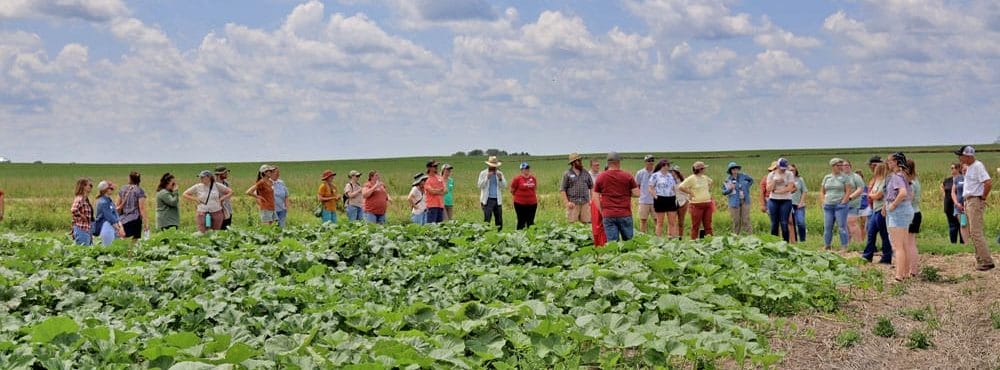Filling Our Cups With Hope
This spring and summer, Practical Farmers staff embarked on a three-part professional development series exploring key aspects of Iowa’s agricultural history and the elements that synergize to create resilient farms and communities.
Like our members, PFI staff come from a range of backgrounds. Because of this, through a series of trainings, we wanted to create a common understanding amongst staff of the history of Iowa’s landscape, people and agriculture so we can work collaboratively toward Practical Farmers’ vision of an Iowa with healthy soil, healthy food, clean air, clean water, resilient farms and vibrant communities.
Part 1 started with an all-day crash course on the history of Iowa agriculture, from pre-colonization to the present. Albert Lacson, who teaches Native and African American history at Grinnell College, shared how Iowa looked before Europeans arrived. Staff learned about Iowa’s unique geographic context within a dynamic transition zone between two adjacent ecosystems, known in biological terms as an ecotone. In this zone, the Midwest’s First Peoples built vast, thriving societies and elaborate trade networks intimately linked with a bison economy.
Sharing a passage from author Robert Morrissey’s book “People of the Ecotone,” Albert helped paint a picture of what this dynamic landscape was like: “Here in the Midwest was a biome-scale transition, the transition between the woodlands of the East and the grasslands of the West. In the heart of this transition, the heart of the Divide, was a special ecology, the tallgrass prairie. Far from monotonous, this landscape was dramatically diverse.”
Leaping forward, Matt Liebman, Iowa State University professor emeritus and a PFI lifetime and board member, contrasted that “dramatically diverse” landscape with Iowa’s landscape now. Through a series of evocative statistics and graphs, Matt showed how rapidly monocultures of corn and soybeans supplanted the once-ubiquitous practice of multi-cropping and extended rotations on Iowa farms. Emphasizing the impact of that mass conversion, Matt shared one particularly startling statistic: “The caloric content of the U.S. corn crop is now 4.3 times greater than the yearly caloric requirement of the entire U.S. population.”
Other speakers guided us through highlights of the social, technological and cultural shifts leading from colonization to the present, including the impact of the 1980s farm crisis and the origins of PFI. Thank you to Albert, Matt, Andy Olson of Tallgrass Prairie Center, Margaret Smith of Albert Lea Seed (and a PFI lifetime member, board member and farmer), changemaker and farmer Denise O’Brien and PFI co-founder Larry Kallem for sharing your wealth of knowledge with us.
Part 2 of our training was all about soils. Lee Burras, soils professor at ISU, shared how Iowa’s soils formed, and how variable Iowa soils are. We learned that today’s soil profiles are significantly different from their natural state. “I have great hopes PFI can reconnect this,” Lee said. “Management changes the profile. That is the intent. Understand it. Own it.” Thank you Lee, and Hillary Olson from Natural Resources Conservation Service, for presenting, and demonstrating, soil health principles to us.
In Part 3, staff shifted from the classroom to the field. We boarded a bus to visit and learn from three central Iowa PFI farm businesses:
Uncle G’s Farm, a small-scale hog and poultry farm near Ogden, operated by Garin and Kristten Buttermore. Garin shared advice to his younger self: “Focus and start small. Get one system down before you try another one.”
Iowa Cover Crop, a full-service cover crop business near Jefferson. Bill and Melissa Frederick and James and Megan Holz explained how their business came to exist and the growth they’ve experienced. When asked what farm groups can do to help businesses like Iowa Cover Crop, James said, “Don’t be too worried about alienating a few people in your base to keep you from working toward the common good.”
Deal’s Orchard, a highly diversified row crop and specialty crop farm near Jefferson. Jerald, Cindy, Chris and Benji took us on a tour and showed us ways the five-generation farm continues to evolve over the years. In recent years, they’ve added hard cider to their mix, greatly enhanced their agritourism offerings (it’s worth a visit if you haven’t been) and just this year planted a high-density orchard.

PFI staff stand in the pumpkin patch at Deal’s Orchard as they listen intently to and ask questions of Chris and Jerald Deal on July 9, 2024.
As usual, this magazine is filled with other stories of innovation and hope, from George Heller and Ethan Book’s flerds to Barb Kraus, Kate Prochaska and Clara Muggli-Toyloy’s flower co-op, and much more. Please read on to fill your cup, too.
Thank you for the hope and ingenuity you lend to the common good,
P.S. If you have ideas on how we can change our tactics to better serve you, please let me know!
